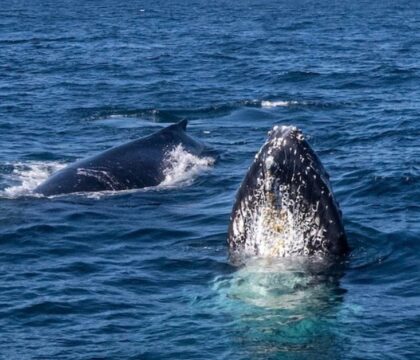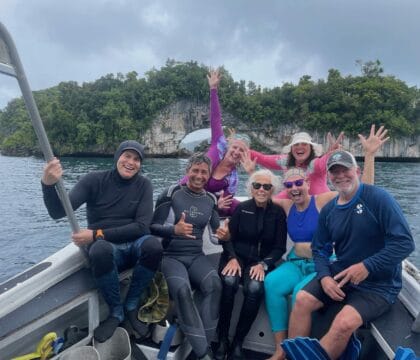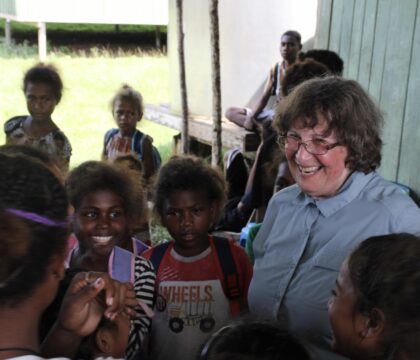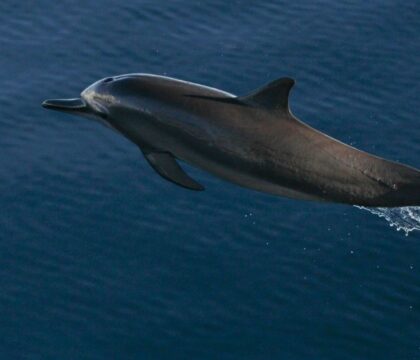January 18, 2018 • Trip Reports
The Coral Triangle Region is home to the highest diversity of corals found anywhere on Earth. © Keoki Stender
Naturalist Keoki Stender shared with us the following detailed trip report and his breathtaking images from a recent Oceanic Society Expedition through the Banda Sea to Raja Ampat, Indonesia by liveaboard. To join us in exploring this amazing region, see our Banda Sea: Reefs, Blue Whales, and Hammerhead Sharks, Raja Ampat Archipelago by Liveaboard, and Raja Ampat: Coral Triangle Adventure expeditions.
Day 1 (9/19/2017): Our Journey Begins – Flores Island
We fly from Bali to the town of Maumere on the huge island of Flores. From the air we see volcanoes with the classic conical shape, very different from gently sloping shield volcanoes in Hawaii, where I live. We arrive at the dusty port town of Maumere and board the ship’s red inflatables for a short ride to the ship anchored offshore. The harbor water is crystal clear, but we must wait until tomorrow to get wet. Each day will consist of snorkeling and diving by day and 100-mile cruises by night as we island hop our way northeast through the Banda Sea to Raja Ampat. We haul anchor and start the 100-mile sail east for the bay of Lewaling. A large pod of spinner dolphins, numbering a few hundred, swim by as the sun sets. Unfortunately, we all see, but miss, the perfect photo opportunity of the dolphin’s aerial acrobatics with the orange sun in the background.
Day 2 (9/20/17): Snorkeling at Lewaling
Today we wake to a dramatic sunrise at the foot of a steep smoking volcano forming the western end of Lewaling Bay. We go on four snorkel outings along the eastern fringing reef with a wide variety of hard and soft corals, small reef fish, and colorful sea slugs. This was a reef subject to human impact; most mound corals were loose and few branching forms were present. At sunset we cruise east overnight to Alor.
A dramatic sunrise at the smoking Lewotolo Volcano from Lewaling Bay. © Keoki Stender
Day 3 (9/21/17): Pura Island and Abui Village Visit
We arrive at the small round island of Pura in the Alor Strait, a basalt cone with dark gray sand and steep, current-swept walls. The kids are very friendly and swim out with homemade goggles to say hello. Many of the children here become expert free divers, as fishing is their primary occupation. Our first snorkel starts in a calm sandy bay with all manner of muck critters, and the current soon leads us along a boulder slope with many anemonefish colonies and swarms of anthias, damselfishes, and fusiliers. The second snorkel has a fast current, with extremely clear water and pockets of cold-water upwelling.
Locals perform a traditional dance in Abui village on Alor. © Keoki Stender
We move to Alor to visit the village of Abui on the island’s north shore. The village abandoned cannibalism after adopting Christianity, but they preserve and share their traditional dances with tourists. They make their living by fishing, farming, and tourism. From here we sail 100 miles east to Wetar, leaving communication with the outside world for a week.
Huge corals and colorful reef fish off the coast of Wetar. © Keoki Stender
Day 4 (9/22/17): Snorkeling At Wetar
The sail had periods of moderately rough seas until we neared Wetar. The small limestone island to the north is lined by undercuts, interrupted by white sandy beaches. In the morning we snorkel the northwest tip of Wetar along a limestone terrace with huge Acropora coral with aggregations of blue chromis and butterflyfishes, in addition to countless other hard and leather coral species. The easterly winds increased by mid-morning, so we had to retreat south one mile, fronting a remote fishing village with a sandy beach. The reef here was a complex of undercut bommies (standalone coral structures) with a different species composition than the first site, and many reef fish, crinoids, and hydroids, as there was copious freshwater input making the water green. A few in our group did a night snorkel and saw many crinoids feeding in the current, sleeping porcupinefish, decorator crab, and bigfin reef squid.
Colorful blue chromis swim above the beautiful reef at Wetar. © Keoki Stender
Day 5 (9/23/17): Wetar’s North Shore
We start heading east along the northern shore of Wetar, making three stops along the way for snorkeling unknown spots, all with strong current. The first point was a small point with huge staghorn Acropora corals and lots of fish and clear water. The current also carried various salps and comb jellies. The second site was a scoured limestone shelf with many leather and a table corals. Both sites had large fish sightings including Napoleon wrasse and bumphead parrotfishes. The final site started out along a barren limestone shelf with shoreline caves and ended among coral gardens with large bumphead parrotfishes. Blue whales and spinner dolphins were encountered during transit.
Huge staghorn Acropora corals. © Keoki Stender
Day 6 (9/24/17): Maopora
We anchor in calm water along Maopora’s deserted west shore fronting a long white beach. We snorkel and dive along a wide fringing reef terrace with the best hard and soft coral gardens thus far. We see a diverse mix of reef fishes including a good number of parrotfishes, emperors, Napoleon wrasses, and dogtooth tuna at depth. Highlights of the day include several octopuses and a two-foot long crocodile flathead. As we sail around the southern tip of Maopora we get very close to a blue whale and see a sperm whale blow in the distance. After dinner I gave a lecture on fish ID for all the guests.
A brightly colored coral hind (Cephalopholis miniata). © Keoki Stender
Day 7 (9/25/17): Teun Volcano
We anchor close to the active crater on the small island of Teun. The crater is a rough, sulfur-lined scar surrounded by the first intact tropical forest we’ve seen thus far. The shoreline is lined by eroding cliffs and submerged boulders quickly sloping to a shallow terrace covered with huge corals of many kinds and lots of reef fish.
This is the most outstanding coral reef I have ever seen.
Sadly, we saw evidence of dynamite fishing and recently dead fish of several species. We also heard two very loud low frequency blasts which Tom, our dive guide, says are volcanic. We also saw bubbles rising from the seafloor, and sulfur-rich sediment clouded the surface water a yellowish green hue.
A pair of panda butterflyfish (Chaetodon adiergastos). © Keoki Stender
Day 8 (9/26/17): Nila & Dusborgh Atoll
We snorkel and dive in the morning at the submerged atoll of Dusborgh. The reef is known for schooling hammerhead sharks but we fail to see any in the morning murk. The reef has a strong current and the best coral is found from 10-25 feet. There’s a decent amount of fish here but the highlight for many is the variety of jellies drifting by. A young Brown Booby lands on the main deck railing for a photo session before heading off. We divert south to the volcanic island of Nila for calmer seas and find another incredible reef with 100% coral cover. After dinner Captain Edi discusses the history and geography of Indonesia and environmental issues at Raja Ampat. We start the overnight transit to Manuk.
Day 9 (9/27/17): Manuk Volcano
Manuk is a small volcano inhabited by thousands of seabirds including Frigates, Boobies, Tropicbirds, and Terns. The underwater landscape consists of nearshore stones and yellow-brown sulfur sand with gas bubbles streaming out at random. I dig down a few inches and feel very warm water. Caverns in the cliff are also bathed in thermally heated water. Remarkably, the nearshore shelf has huge plate and lobe corals before the steep, current-swept wall descends into deep water. Along the wall we see large dogtooth tuna, Napoleon wrasse, hammerhead sharks, and one thresher shark. Snorkeling was especially rewarding with many large reef fish in very clear water. After the morning snorkel, we motor offshore to see a pod of shortfin pilot whales. We start the transit to Banda Naira after two afternoon snorkels.
A spectacular nudibranch (Goniobranchus albopunctatus). © Keoki Stender
Day 10 (9/28/17): Banda Naira, Day 1
We sail around the southwestern Banda Islands and find a blue whale in the distance, but choppy conditions send us into scenic Banda Naira Harbor for snorkeling on a remarkably beautiful coral reef on the 1989 lava flow. It is incredible to see how large corals can grow in perfect conditions. The fish community here is especially good considering the proximity of town. We snorkel again after lunch, north of the green lighthouse in a moderate current that feeds swarms of fish and encrusting invertebrates. At dusk, we snorkel along the harbor seawall to observe pairs of mandarinfishes doing their courtship dance. With the first cellular reception in several days, we hear that Bali’s volcano may erupt at any moment, which is a big worry for everyone.
Day 11 (9/29/17): Banda Naira, Day 2
We start with a walking tour of the old town, museum, Dutch fort, and street market, learning about the region’s history, and we sample the nutmeg, mace, and cinnamon that earned this region the name “Spice Islands.” The fort is a large pentagon with a 360-degree view of the harbor. After breakfast we return to the lava flow for more snorkeling, and then depart the harbor for an after lunch snorkel at the northwest tip of Banda Besar. We then sail northeast for Koon, the southern gateway to Raja Ampat.
An Oceanic Society traveler photographs blue chromis on the reef. © Keoki Stender
Day 12 (9/30/17): Koon & Madorang
We arrive at the first low island of Koon, a series of sandy cays bordering a huge oval reef system. We dive the southeast tip over a shallow plateau bordered by deep, clear water teeming with large fish and turtles. The sea is glassy and current is mild so we can relax and explore while curious locals look on. After lunch, we sail northwest to the small coral island of Madorang and dive along a vertical wall lined with huge branching Acropora corals, swarms of anthias, and tons of big reef fish. We start heading north for Misool, the southern end of Raja Ampat.
Day 13 (10/1/17): Misool, Day 1
Our first day in Raja Ampat starts with heavy overcast and rain. We start snorkeling around jagged and heavily forested limestone islets. The underwater terrain is very complex, with pinnacles, ridges, and submerged passages. The quantity and variety of fish here is outstanding. We see all manner of reef fish and top carnivores including sharks, trevallies, Napoleon wrasses, barracuda, and snappers to name a few. The rain ends by late morning and we enjoy the warmth and try a sunset snorkel.
Day 14 (10/2/17): Misool, Day 2
Morning begins with a sea eagle snatching anchovies from the surface. We continue snorkeling among current-fed rock pinnacles then move north to a larger island after lunch. We cruise through a maze of jungle-clad limestone to swim in an isolated brackish lagoon with small moon jellies. The corals here fluoresce jade green and blue gray at the base of undercut cliffs. The sunset snorkel fronting an abandoned resort has a variety of different species seen thus far including red crinoids, ghost pipefish, and Thuridilla slugs. We sail north for Batanta.
Day 15 (10/3/17): Batanta, Day 1
We arrive at Dayang Island near the northwest end of Batanta, where the next Survivor program is being recorded. The dive site is a sandy ridge with several large coral outcrops bathed by a strong current. A few manta rays visited cleaner wrasse stations at these outcrops during the late morning session. After successfully seeing mantas and nudibranchs we move east to an offshore reef named Larry’s Dream with very clear water and endless fields of coral and fish. We surface to find Pindito with her sails deployed as we move farther east and anchor in a quiet lagoon and enjoy a beautiful sunset as various birds including hornbills return for the night.
A seemingly endless bed of hard coral at Pulau Wai. © Keoki Stender
Day 16 (10/4/17): Batanta, Day 2
A few in our group wake up before dawn to take a trip through the mangrove lagoon to see and hear a variety of birds including White Cockatoos. The birds are far off, but their songs fill the morning calm in all directions, the best surround sound experience I’ve ever had. I can’t help but notice perfect mandarinfish habitat lining the lagoon edges along the way. Heading back to the ship, we run across a group of tuna leaping out of the water feeding upon anchovies—a strange sight 100 feet from the mangrove forest. Just before we pull alongside the ship, a bottlenose dolphin and calf ride our bow wake. After breakfast, we head north to an offshore island in the Dampier Strait known as Pulau Wai for our final two snorkel sessions. Wai had a wide, shallow terrace bathed by crystal clear current with endless beds of hard coral. The best area was the reef flat, where multicolored beds of staghorn, antler, table, mound, and rose coral grow so shallow that I could barely float above them. Along the dropoff we saw huge bumphead parrotfishes, Napoleon wrasses, sharks, turtles, titan triggerfishes, and the usual host of reef fish. We start the last leg of the trip into Sorong as it begins to rain. We dry and pack our bags and the crew prepares an Indonesian feast. We finally meet the crew all together and view a slideshow of our best photos and trip summary by the dive staff.
The corals at Pulau Wai were a spectacular finish to our expedition. © Keoki Stender
Day 17 (10/5/17): Sorong – Departure
It stopped raining! I was worried about our luggage and clothes getting soaked on the way back to shore, but the morning is warm and humid. We say our goodbyes and head to the airport. We have two flights to get back to Bali, both are delayed at least an hour. Thankfully our connecting flights are not until evening and the airports are cool and remarkably nice and comfortable—much better than Honolulu, which is sad. After two days and five flights I return home. It doesn’t feel like I’ve been gone for three weeks but my kitten is twice as big! Now I have to scour through 6,500 photos and pick a few for this blog!
The dramatic corals at Pulau Wai. © Keoki Stender
During the past 17 days we had the rare opportunity to explore a wide variety of reefs and islands over a 1,100-mile stretch of the Banda Sea and Dampier Strait. We swam around active volcanoes, ancient fossil reefs, submerged atolls, mangrove lakes, and saw blue whales at sea. We also visited a traditional village and colonial fort. We saw hundreds of coral and fish species in great abundance, while just scratching the surface of what the region has to offer. Last but not least we made new friends with fellow ocean lovers.




